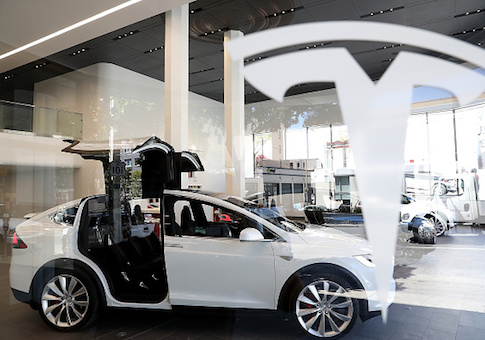Earlier this week a colleague and I test drove a Tesla Model X. I immediately pictured the cars from Minority Report. All you have to do is just sit and stare—the driverless machine does the rest. But this isn't 2054. Fully autonomous vehicles (for better or for worse) are still a thing of the future. But it was nonetheless fascinating.
From the outside, the Model X is a sleek, almost nondescript SUV—save for the "T" on the grill and its bat-like headlights. Then the second-row doors open—falcon wings reminiscent of the gullwings on the classic Mercedes-Benz 300SL. After programming my destination on a screen the size of an iPad, I learn that the Tesla isn't going to steer its way there. I actually have to drive the car. (This itself was a bit confusing since I tried shifting gears. I assumed it was jammed until I realized it's just a switch—there is no shifting gears since the engine is electric, not combustion. It's a single-speed transaxle gearbox.)
We drove a total of 10 miles. On the local roads at speeds of less than 30 mph (this is Arlington on a Monday morning), the Model X handled smoothly, like any other luxury SUV. But once we got onto I-66, I activated the Autopilot, allowing the vehicle to think more for itself. It's a strange sensation and not necessarily one that made me want to relax, take a nap, or watch a movie. On the contrary, I was mesmerized and monitored the traffic around me with greater scrutiny. I watched eagerly as the Tesla made use of its "neural network," maintaining a steady speed and safe distance from the car in front of it. I flipped on the left turn signal and waited as the Model X used one of its eight cameras to figure out when to change lanes. We came to a bend on the interstate and a lane merge. Our car stayed in its lane, making room for the other vehicles.
I'm told to keep a hand on the steering wheel, even, from time to time, giving it a slight shake. Going hands-free for an extended period will trigger an alert—a reminder that this is a semi-autonomous machine. "So what's the point?" asked a skeptical friend. As others have pointed out, the autopilot needs to be viewed at this juncture as similar to the autopilot on an aircraft—you still need a pilot in the seat. The feature just allows you to keep track of fewer things. At least that's my guess. In any event, my natural driving instincts took over. Out of habit, I pumped the brake, disengaging the Autopilot.
Keep in mind if you set your destination, Autopilot will not take you off the interstate, up the ramp, and onto local roads. Any break in the painted road lines can slow it down as it figures out what to do. But say you are going within the Tesla's roughly 200-mile range mostly on a highway. Autopilot is ideal.
And yet for me, Autopilot was not the most memorable aspect of the car. Rather, it was the acceleration and something called Ludicrous Mode (a nice homage to Space Balls). Just be prepared—it launches the car forward as if it were a high-velocity rollercoaster. In short: You’ll go from 0 to 60 mph in about 2.9 seconds. When the traffic light turns green, there is little question you will zoom past almost any sportscar in the neighboring lane. Unless it’s, say, the Porsche 918 Spyder, which goes from 0 to 60 in 2.2 seconds. But again, we are talking about an SUV*. (As Road & Track points out, Tesla doesn't make the fastest cars per se, but it does make the quickest cars.)
Ludicrous speed with electric power. No revving up necessary—that to me was the biggest selling point. Immediate and adrenaline-intense acceleration. Just be sure to charge up that battery—going ludicrous can take up a chunk. Recharging usually takes 30 minutes. The trick is finding those electric stations.
So as you can see, the future is not yet here. (I realize that sounds like a bookend to George W. Bush’s line about agreeing "the past is over.") We have not yet reached the point of operating fully autonomous—and affordable—vehicles. The base price of the latest Model X 90D with Enhanced Autopilot** is $99,000. Yes, there are tax credits and subsidies. (I am going to leave that policy discussion for another time.)
But the technological advances being made are nevertheless impressive. The Model X has both radar and sonar. Plus the notion of a world filled with non-gasoline-powered cars is worth some consideration. "And how do you think those cars will power up their electric motors?" my skeptical friend asked. I told him I was fine with nuclear.
*Whether or not you purchase a sports-utility vehicle is an entirely separate issue. Just remember, as P.J. O’Rourke reminds us, "SUVs provide America with economic stimulus. Replacing parking meters, fire hydrants, street signs, gates, fences, decorative plantings, HANDICAPPED ONLY markers, bumpers, fenders, hoods, and trunk lids that have been backed into by SUVs is a multibillion-dollar business in the United States, and provides tens of thousands of jobs."
**The difference between Autopilot and Enhanced Pilot: The latter is less likely to kill you on outer space missions while obtaining a Xenomorph specimen. Kidding!
